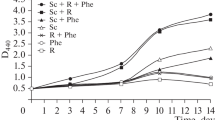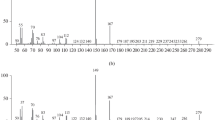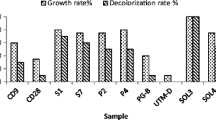Abstract
The biodegradation of the polycyclic aromatic hydrocarbon phenantherene by the rhizobacterial strain Ensifer meliloti P221, isolated from the root zone of plant grown in PAH-contaminated soil was studied. Bacterial growth and phenanthrene degradation under the influence of root-exuded organic acids were also investigated. Analysis of the metabolites produced by the strain by using thin-layer chromatography, gas chromatography, high-pressure liquid chromatography, and mass-spectrometry revealed that phenanthrene is bioconverted via two parallel pathways. The first, major pathway is through terminal aromatic ring cleavage (presumably at the C3–C4 bond) producing benzocoumarin and 1-hydroxy-2-naphthoic acid, whose further degradation with the formation of salicylic acid is difficult or is very slow. The second pathway is through the oxidation of the central aromatic ring at the C9–C10 bond, producing 9,10-dihydro-9,10-dihydroxyphenanthrene, 9,10-phenanthrenequinone, and 2,2′-diphenic acid. This is the first time that the dioxygenation of phenanthrene at the C9 and C10 atoms, proven by identification of characteristic metabolites, has been reported for a bacterium of the Ensifer genus.





Similar content being viewed by others
References
Afzal M, Yousaf S, Reichenauer TG, Sessitsch A (2012) The inoculation method affects colonization and performance of bacterial inoculant strains in the phytoremediation of soil contaminated with diesel oil. Int J Phytorem 1:35–47
Ahmad D, Mehmannavaz R, Damaj M (1997) Isolation and characterization of symbiotic N2-fixing Rhizobium meliloti from soils contaminated with aromatic and chloraromatic hydrocarbons: pAHs and PCB. Int Biodeterior Biodegrad 39:33–43
Andreoni V, Cavalca L, Rao MA, Nocerino G, Bernasconi S, Dell’Amico E, Colombo M, Gianfreda L (2004) Bacterial communities and enzyme activities of PAHs polluted soil. Chemosphere 57:401–412
Baboshin MA, Baskunov BP, Finkelstein ZI, Golovlev EL, Golovleva LA (2005) The microbial transformation of phenanthrene and anthracene. Microbiology 74:303–310
Baboshin M, Akimov V, Baskunov B, Born TL, Khan SU, Golovleva L (2008) Conversion of polycyclic aromatic hydrocarbons by Sphingomonas sp. VKM B-2434. Biodegradation 19:567–576
Doddamani HP, Ninnekar HZ (2000) Biodegradation of phenanthrene by a Bacillus species. Curr Microbiol 41:11–14
Frassinetti S, Setti L, Corti A, Farrinelli P, Montevecchi P, Vallini G (1998) Biodegradation of dibenzothiophene by a nodulating isolate of Rhizobium meliloti. Can J Microbiol 44:289–297
Hadibarata T, Tachibana S (2010) Characterization of phenanthrene degradation by strain Polyporus sp. S133. J Environ Sci 22:142–149
Johnsen A, Wick LY, Harms H (2005) Principles of microbial PAH-degradation in soil. Environ Pollut 133:71–84
Jones D (1998) Organic acids in the rhizosphere—a critical review. Plant Soil 205:24–44
Juhasz AL, Naidu R (2000) Bioremediation of high molecular weight polycyclic aromatic hydrocarbons: a review of the microbial degradation of benzo[a]pyrene. Int Biodeterior Biodegrad 45:57–88
Kanaly RA, Harayama S (2000) Biodegradation of high molecular weight polycyclic aromatic hydrocarbons by bacteria. J Bacteriol 182:2059–2067
Karasevich YuN (1982) Osnovy selektsii mikroorganismov, utiliziruyushchihk synteticheskiye organicheskie soedineniya (The basis of selection of microorganisms utilizing synthetic organic compounds). Nauka, Moscow (in Russian)
Keum YS, Seo JS, Li QX (2005) Degradation pathways of phenanthrene by Sinorhizobium sp. C4. Appl Microbiol Biotechnol 35:2685–2693
Kim YH, Freeman JP (2005) Effects of pH on the degradation of phenanthrene and pyrene by Mycobacterium vanbaalenii PYR-1. Appl Microbiol Biotechnol 67:275–285
Labidi M, Ahmad D, Halasz A, Hawari J (2001) Biotransformation and partial mineralization of the explosive 2,4,6-trinitrotoluene (TNT) by rhizobia. Can J Microbiol 47:559–566
Latha S, Mahadevan A (1997) Role of rhizobia in the degradation of aromatic substances. World J Microbiol Biotechnol 13:601–607
Lopez Z, Vila J, Ortega-Calvo J–J, Grifoll M (2008) Simultaneous biodegradation of creosote-polycyclic aromatic hydrocarbons by a pyrene-degrading Mycobacterium. Appl Microbiol Biotechnol 78:165–172
Mallick S, Chatterjee S, Dutta TK (2007) A novel degradation pathway in the assimilation of phenanthrene by Staphylococcus sp. strain PN/Y via meta-cleavage of 2-hydroxy-1-naphthoic acid: formation of trans-2,3-dioxo-5-(29-hydroxyphenyl)-pent-4-enoic acid. Microbiology 153:2104–2115
Moody JD, Freeman JP, Doerge DR, Cerniglia CE (2001) Degradation of phenanthrene and anthracene by cell suspensions of Mycobacterium sp. strain PYR-1. Appl Environ Microbiol 67:1476–1483
Muratova A, Hübner Th, Tisher S, Turkovskaya O, Möder M, Kuschk P (2003) Plant–rhizosphere-microflora association during phytoremediation of PAH-contaminated soil. Int J Phytorem 5:137–151
Muratova AYu, Golubev SN, Merbach W, Turkovskaya OV (2009) Biochemical and physiological peculiarities of the interactions between Sinorhizobium meliloti and Sorghum bicolor in the presence of phenanthrene. Microbiology 78:308–314
Neumann G, Römheld V (2000) The release of root exudates as affected by the plant physiological status. In: Pinton R, Varanini Z, Nannipieri Z (eds) The Rhizosphere: biochemistry and organic substances at the soil-plant interface. Marcel Dekker Inc., New York, pp 41–93
Phaengthai S, Pattaragulwanit K, Pinphanichakarn P, Juntongjin K, Thaniyavarn S (2000) Biodegradation of polycyclic aromatic hydrocarbons by Rhizobium sp. CU-A1. Abstract book of the 12th annual meeting of the Thai Society for Biotechnology, Kanchanaburi, 1–3 Nov 2000
Poonthrigpun S, Pattaragulwanit K, Paengthai S, Kriangkripipat T, Juntongjin K, Thaniyavarn S, Petsom A, Pinphanichakarn P (2006) Novel intermediates of acenaphthylene degradation by Rhizobium sp. strain CU-A1: evidence for naphthalene-1,8-dicarboxylic acid metabolism. Appl Environ Microbiol 72:6034–6039
Rentz JA, Alvarez PJJ, Schnoor J (2004) Repression of Pseudomonas putida phenanthrene-degrading activity by plant root extracts and exudates. Environ Microbiol 6:574–583
Samanta SK, Chakraborti AK, Jain RK (1999) Degradation of phenanthrene by different bacteria: evidence for novel transformation sequences involving the formation of 1-naphthol. Appl Microbiol Biotechnol 53:98–107
Samanta SK, Singh OV, Jain RK (2002) Polycyclic aromatic hydrocarbons: environmental pollution and bioremediation. Trends Biotechnol 20:243–248
Seo JS, Keum YS, Hu Y, Lee SE, Li QX (2006) Phenanthrene degradation in Arthrobacter sp. P1-1: initial 1,2-, 3,4- and 9,10-dioxygenation, and meta- and ortho-cleavages of naphthalene-1,2-diol after its formation from naphthalene-1,2-dicarboxylic acid and hydroxyl naphthoic acids. Chemosphere 65:2388–2394
Seo JS, Keum YS, Li QX (2009) Bacterial degradation of aromatic compounds. Int J Environ Res Public Health 6:278–309
Shamsuzzaman KM, Barnsley EA (1974) The regulation of naphthalene oxygenase in pseudomonads. J Gen Microbiol 83:165–170
Stulke J, Hillen W (1999) Carbon catabolite repression in bacteria. Curr Opin Microbiol 2:195–201
Vela S, Haggblom MM, Young LY (2002) Biodegradation of aromatic and aliphatic compounds by rhizobial species. Soil Sci 167:802–810
Young JM (2003) The genus name Ensifer Casida 1982 takes priority over Sinorhizobium Chen et al. 1988, and Sinorhizobium morelense Wang et al. 2002 is a later synonym of Ensifer adhaerens Casida 1982. Is the combination “Sinorhizobium adhaerens” (Casida 1982) Willems et al. 2003 legitimate? Request for an Opinion. Int J Syst Evol Microbiol 53:2107–2110
Acknowledgments
This work was supported in part by the Federal Special Program “Research and Development in Priority Fields of Science and Technology of Russia, 2007–2012″ (state contract no. 02.512.11.2210) and by the Russian Foundation for Basic Research (Grant No. 13-04-02051).
Author information
Authors and Affiliations
Corresponding author
Rights and permissions
About this article
Cite this article
Muratova, A., Pozdnyakova, N., Makarov, O. et al. Degradation of phenanthrene by the rhizobacterium Ensifer meliloti . Biodegradation 25, 787–795 (2014). https://doi.org/10.1007/s10532-014-9699-9
Received:
Accepted:
Published:
Issue Date:
DOI: https://doi.org/10.1007/s10532-014-9699-9




